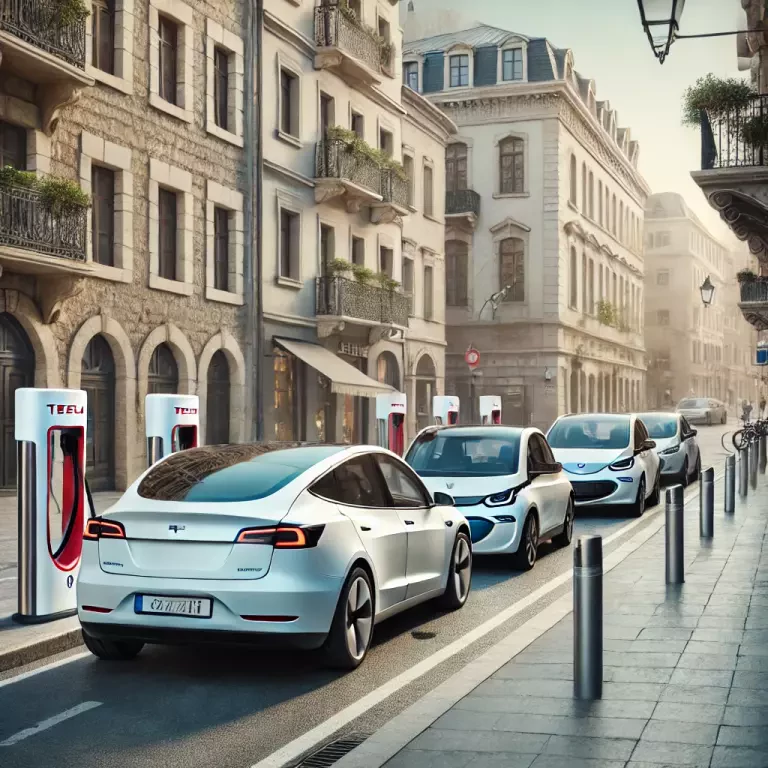
With the global shift towards green technology, electric vehicles (EVs) are gaining traction worldwide. As thousands of consumers look to make environmentally friendly choices, the question arises—can you ship an EV from the US to Europe?
This article will provide a comprehensive overview of the entire process. From the necessary paperwork to different options, we’ll delve into the advantages and disadvantages of exporting EVs, helping readers make informed decisions on this eco-friendly option.

Understanding the Buying Process
When considering moving an electric vehicle, you need to understand the complexities of the buying and process. Purchasing an EV for export involves several steps, including selecting the right auto that meets your needs and budget, securing a purchase from a dealer or private seller, and coordinating with a company specializing in hauling to your country of choice.
Let’s examine the more specific aspects of the import process, starting with the documentation required to bring an EV into Europe.
Necessary Documentation
When importing from the US to a foreign country, prepare to present a series of documents required by customs authorities to process the importation. The mandatory documentation typically includes the following:
- Proof of ownership
- A sales invoice
- A Bill of Lading
- Export declaration (if required by US customs)
Depending on the destination country, additional documents may be demanded upon the EV’s arrival, such as a European Certificate of Conformity certifying that it meets European safety and environmental requirements. All cars entering the European industry must comply with the country's specifications.
Compliance with Emissions Standards
A battery-charged automobile offers a sustainable alternative to internal combustion engines with zero tailpipe emissions. However, countries in Europe have specific regulations regarding homologation. The good news is that EVs generally meet stringent emissions standards due to their eco-friendly nature, however, there are still other technical standards related to safety and design that must be met.
Tax Implications of Importing
Finally, the import costs can be significant. Moving in a vehicle typically incurs several different import taxes and fees, including import duties, Value Added Tax (VAT), and possibly others, such as registration taxes determined by the resident country.
The import duty rate for vehicles can vary, but EVs often benefit from lower rates due to their environmentally friendly nature. In some cases, EVs can be exempt from certain import taxes as part of incentive programs to promote the use of greener motorcars. VAT rates similarly differ across Europe and are applied to the total cost, including moving and insurance.
Options for Electric and Hybrid Vehicles for Export
You'll find many options available when considering the export of electric and hybrid ones. From popular models to lesser-known vehicles, there's a wide range to choose from. The important thing is that you do your research for whichever car you're considering to ensure it meets any requirements for importing.
Popular Models
When moving, certain models stand out due to their popularity and brand recognition. Models such as the Tesla Model S and Model 3, the Chevrolet Bolt EV, and the Nissan Leaf have proven to be favorites in the export market. These are known for their range, reliability, and advanced technology, making them desirable to consumers seeking high-quality electric cars.

Hybrid Choices
Exports are also a viable option, meeting the needs of consumers who desire fuel efficiency with the flexibility of a gasoline engine. Popular hybrid choices for export include the Toyota Prius, known for its fuel economy and reliability; the Honda Accord Hybrid, which offers a comfortable ride with efficient performance; and the Ford Fusion Hybrid, a stylish alternative with a strong eco-friendly appeal.
Considerations for Condition and Suitability
Before exporting an EV or hybrid one, assessing its condition and suitability for the European market is critical. First, ensure it meets the specific standards and regulations, including emission standards and safety features. Additionally, check that its onboard diagnostics and software are compatible with networks to avoid any technical issues.
The autos warranty should also be considered to determine if it will remain valid in the destination country or if any additional coverage needs to be purchased. It's key to verify that the EV's battery health is optimal, as a deteriorating battery can significantly impact its range and functionality, potentially causing difficulties for users.
Exporters must also be aware that left-hand-drive vehicles are more suitable for most European countries, as opposed to right-hand-drive ones, which are used in countries like the UK and Ireland. Ensuring the exported motorcar is appropriate for the roads and driving customs of its new environment is essential for a successful exportation process.
Logistical Aspects
When moving, there are several logistical aspects to consider that will ensure its safe and efficient hauling. Careful planning is essential to navigate the complex process of international delivery. Here's what you need to know:
Moving Methods and Costs
For hauling overseas, you can choose between container and Roll-on/Roll-off (RoRo) services:
- Container Method: Your EV is secured inside a standard 20—or 40-foot container. This method offers greater protection against external elements and is preferred if you are hauling a high-value or sensitive vehicle. Costs may vary depending on the size of the container and the company.
- RoRo: It is driven onto the ship and secured to the car deck. This method is more cost-effective and suitable for autos in running conditions.
The cost can fluctuate based on several factors, including which professional service is chosen, the size and weight of the EV, the departure and arrival ports, the season, and the level of service required. Additional costs such as insurance, import taxes, and port charges may also apply. You can get quotes from several companies to compare prices and the quality of customer service.

Understanding Transit Times and Routes
Typical transit times range from 1-4 weeks but can be longer due to unforeseen delays such as inclement weather, port congestion, or customs clearance processes.
Popular routes from the US to Europe often start from ports like New York, Los Angeles, or Miami and can arrive at European destinations, including Rotterdam, Bremerhaven, or Southampton. It is important to discuss the optimal routes and possible transit times for your specific situation with your freight forwarder.
Conclusion
Moving requires careful consideration and planning, but it is possible. By being informed and proactive, you can enjoy a smooth import process that successfully hauls across the Atlantic, ready for your adventures.
If you're ready to move forward with your plans to move, consider hiring A1-AT for the job. With reliable customer service and various options, we're prepared to fit your needs. Reach out to one of our agents and get your free quote today!






 Share on Facebook
Share on Facebook Share on LinkedIn
Share on LinkedIn Share on Twitter
Share on Twitter




 Google
Google  Instagram
Instagram  Trustpilot
Trustpilot 



